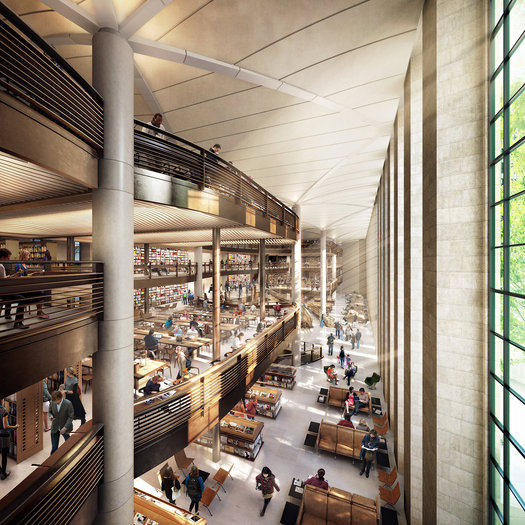
Several months ago I protested in this space that the NYPL, after years of promises, had not put forth a model of the proposed renovations that would transform its main research library for the first time in a century. Today, those plans, authored by Norman Foster, are before us, and while they are not as catastrophic as they might have been, and while there are aspects that are appealing, they are not good enough. Like many others, I still have considerable reservations as to the benefits and necessity of this entire endeavor. But even accepting the Library's assumptions, the new design is underwhelming. For something so long promised and delivered with such great fanfare, it is surprisingly lacking in architectural ambition and imagination.
Foster's plan would open up the stacks to create a circulating library-within-the-library, and insert an atrium on the west side of the building, facing Bryant Park. Primary access would be from the main Fifth Avenue entrance, through what is now the museum's principal exhibition space. The plan indicates that this is to be enhanced as gallery space — it is now a dank, difficult room — but how running a high-traffic circulation path through it will make it better for display I don't quite understand. Several entryways appear way too small for the traffic they will be forced to handle — already a problem, before the expansion. A new center for writers would take the place of the old Slavic Study Center, on the second floor. This is welcome, though it's unfortunate that the Library has seen fit to give up on one of its great collections.
By now, the atrium is familiar as Foster's go-to strategy for major renovation projects, and here he seems to have put the architectural cart before the horse. As has been repeatedly pointed out (especially by Charles Warren), the stacks cannot be removed easily from this building; they provide structural support. This might have been a starting point for an innovative design — Foster has a distinguished history of technical innovation — but apparently the problem has not yet been addressed; it is an afterthought.
It has also been noted that the new plans provide no service path to deliver books from their primary storage space beneath Bryant Park to the main research reading rooms. It has been suggested that a delivery system might be inserted into mechanical space between floors. But again, here is a central programmatic problem that hadn't even been considered. One can't help but ask why this process was not given a central consideration in the planning? (As, say, at Rem Koolhaas's library in Seattle, or Helmut Jahn's Mansueto library in Chicago.) Shouldn't any design for a new library celebrate the delivery of information, in all its forms: books, magazines, electronic files, etc.? Wouldn't that be more exciting than another uninspired corporate atrium, one that, if the renderings are any indication, seems likely to be plagued by the very problems — noise, traffic, crowds — that afflict the Mid-Manhattan library it is set to replace? Certainly, as presented, Foster's renovation hardly ranks as a work of tremendous architectural distinction; it looks like a bloated Barnes & Noble.
When it opened, back in 1911, the NYPL was deservedly proud of its technological innovations. A cutaway diagram of the building appeared on the cover of Scientific American — it is still a point of pride among library staffers. That drawing should be an inspiration for any alterations to the library, for it is a metaphor for everything the building should be about: the advance of ideas through their physical embodiment. That's the kind of architecture New York City deserves.
Follow: @marklamster
